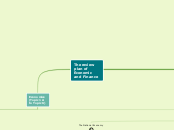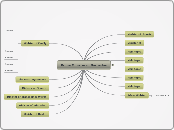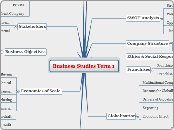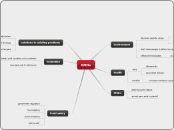The review plan of Economic and Finance
Statistics (Topic 10 )
Corporate and Finance (Topic 7-Topic 9)
分支主題
Economics (Topic 1 A to Topic 6)
Macroeconomics(Topic 4 to Topic 6)
Banking, Money and Interest Rates
Equilibrium in the Money Market
The Demand for Money
The Supply of Money
The Financial System
The Meaning and Functions of Money
means of establishing value of future claims and payments
means of storing wealth
means of evaluation
medium of exchange
Relationship between Unemployment and Inflation
Subtopic
The Phillips curve
Inflation
Policies to tackle inflation
the total expenditure (MV) equals the nominal GDP (PY)
The quantity theory of money
The equation of exchange: MV = PY
real value of national income
price index
velocity of circulation
the average number of times annually that money is spent on goods and services
M money supply
structural (demand shift)
expectations and inflation
supply-side policies (affect AS)
increase productivity
reduce monopoly power
demand-side policies (affect AD)
Monetary policy
Interest rate decrease lead to borrowing cheaper lead to Arrogate demand increase
the central bank altering the supply of money in the economy or manipulating the rate of interest
Fiscal policy
expansionary:G rise lead to T decrease
contractionary:G increase lead to T rise
altering the level of government expenditure (G) and/or rate of tax (T)
Types of inflation
interaction of demand-pull and cost-push inflation
cost push
demand pull
Defining inflation
Unemployment
equilibrium unemployment
seasonal unemployment
structural unemployment
regional unemployment
technological unemployment (labour-saving technology)
changing pattern of demand
frictional (search) unemployment
takes time for workers to find jobs (imperfect information)
results from workers who are between jobs
disequilibrium unemployment
unemployment arising from a growth in the labour supply
demand-deficient (cyclical) unemployment
real-wage (classical) unemployment
The National Economy
Economic groth
Long-term gowth
Short-term gowth
the business cycle
slowdown or recession
peaking out
expansion
upturn
actual growth
VS potential economic growth
Measuring National Income
Net national income (NNY)
Gross national income (GNY)
Gross Domestic product (GDP)
the expenditure method
the income method
the product method
The Circular Flow of Income
The circular flow and the four macroeconomic objectives
J>W -> a rise in aggregate demand -> economic growth; unemployment falls; inflation rises; import rises and export falls
Equilibrium in the circular flow
The relationship between injections and withdrawals
Injections (J)
export expenditure (X)
government expenditure (G)
investment (I)
Withdrawals (W)
import expenditure (M)
net taxes (T)
net saving (S)
The inner flow
Consumption of
domestically
produced goods
and services (Cd)
Factor
payments
The Scope of Macroeconomics
Macroeconomic policy objectives
A stable financial system
the exchange for Min fluctuation
Balance the payment
Low inflation
Low unemployment
High and stable economic growth
The major macroeconomic issues
balance of payments and exchange rates
inflation
unemployment
economic growth
Microeconomics (Topic 1 B -Topic 3)
Market structure
Monopoly market
Downward sloping, more inelastic than oligopoly. Firm has considerable control over price
Produce the Unique products
Restricted or completely blocked to entry the market
Only one firm
Oligopoly market
Downward sloping, relatively inelastic for demand curve(shape depends on reactions of rivals)
Produce the differentiated products or Undifferentiated products
Restricted to entry the market
Few firms in this market
Monopolistic competition market
Downward sloping,
but relatively elastic for demand curve
Produce the differentiated products
Several firms in the market
Perfect competition market
Horizontal:The firm is a price taker
produce the undifferentiated products
Unrestricted to entry
Many firms
Markets in Action (Elasticity)
Indirect Tax
Implications for tax policy
Elasticity and the incidence of taxation
The incidence of taxation
the consumers' share
the producers' share
Effects on supply curve
ad valorem tax(从价税)
specific tax
Elasticity
Cross-price elasticity of demand(需求交叉价格弹性)
Goods are Substitutes
CeD will be positive
Goods are compliments
CeD will be negative
Goods are related or unrelated
CeD = 0 (or close to 0) suggests no significant relationship
closeness as substitutes or complements
measurement: The percentage change in quantity demanded for Good a divided by the percentage change in price
Income elasticity of demand
applications
A negative result denotes an inferior good
A positive result denotes a normal good
proportion of income spent on the good
degree of necessity
measurement:Percentage change in quantity demanded divided by percentage change in income
Price elasticity of supply
determinants
time period
the amount that costs rise as output rises
measurement:Percentage change in quantity supply divided by percentage change in price
Price elasticity of demand
Price elasticity of demand and consumer expenditure
effects of a price change on expenditure: inelastic demand
effects of a price change on expenditure: elastic demand
Total consumer expenditure (TE)=P*Q = Firm's total revenue
Determinants of price elasticity of demand
time
the proportion of income spent on the good
substitute goods
The value: Great or less than one (ignore the negative sign)
PeD infinity: perfectly elasticity,horizontal demand curve
PeD is = 0 , perfectly in-elasticity,Vertical demand curve
PeD is =- 1: Unit elasticity of demand,unitary elastic
PeD is < 1: inelastic; steeper demand curve
PeD is > 1: elastic; flatter demand curve
The sign :Negative
Measurement: Percentage change in quantity demanded divided by percentage change in price
Definition:The responsiveness of demand to change in price
Definition: the responsiveness of demand and suplly
Demand and Supply
Price control
Maximum price( price ceiling)
Minimum price(Price floor)
Price and output determination (D=S)
Non-price factors:Shift (Increase and decrease)
Price factors:Move along(expansion and contraction)
Demand curve and Supply curve
Supply curve
Demand curve
movements
Shapes of the curve
Basic concepts of Economics (Topic 1 A)
Economic system
Mix market system
Free market system
Command system
The filed of economist study
Microeconomics field
The circular flow of income
microeconomic objectives
rational economic decision making
The concept of opportunity costs
production possibility curve
unattainable
full efficiently
unefficiently
The study field of Macroeconomic
Macroeconomic policies
Demand-side policy
Supply-side policy
Macroeconomic issues
The cyclical fluctuation of national economic
Balance of trade (Import and export)
The inflation of national economic
The rate of unemployment of population
The recession of National economic
The growth of National economic
Economic problems
scarcity-the central economic problem
Supply and demand
actual and potential supply and demand
importance of recording supply and demand
Factors of production
capital
land and raw materals
labour
Definition of scarcity
Production and consumption









